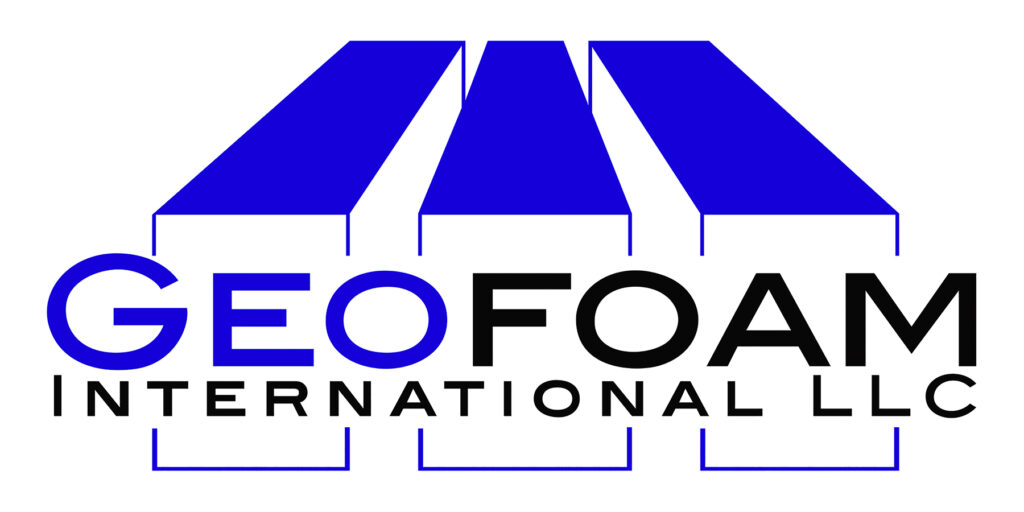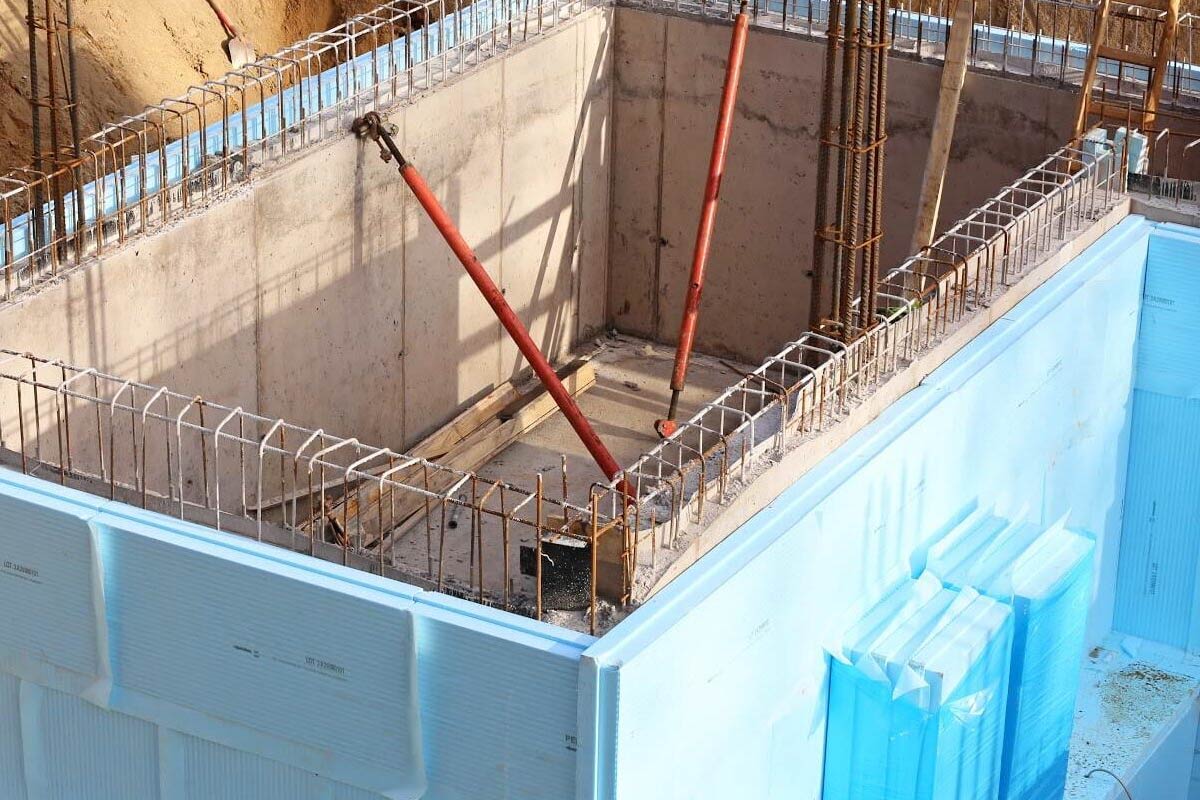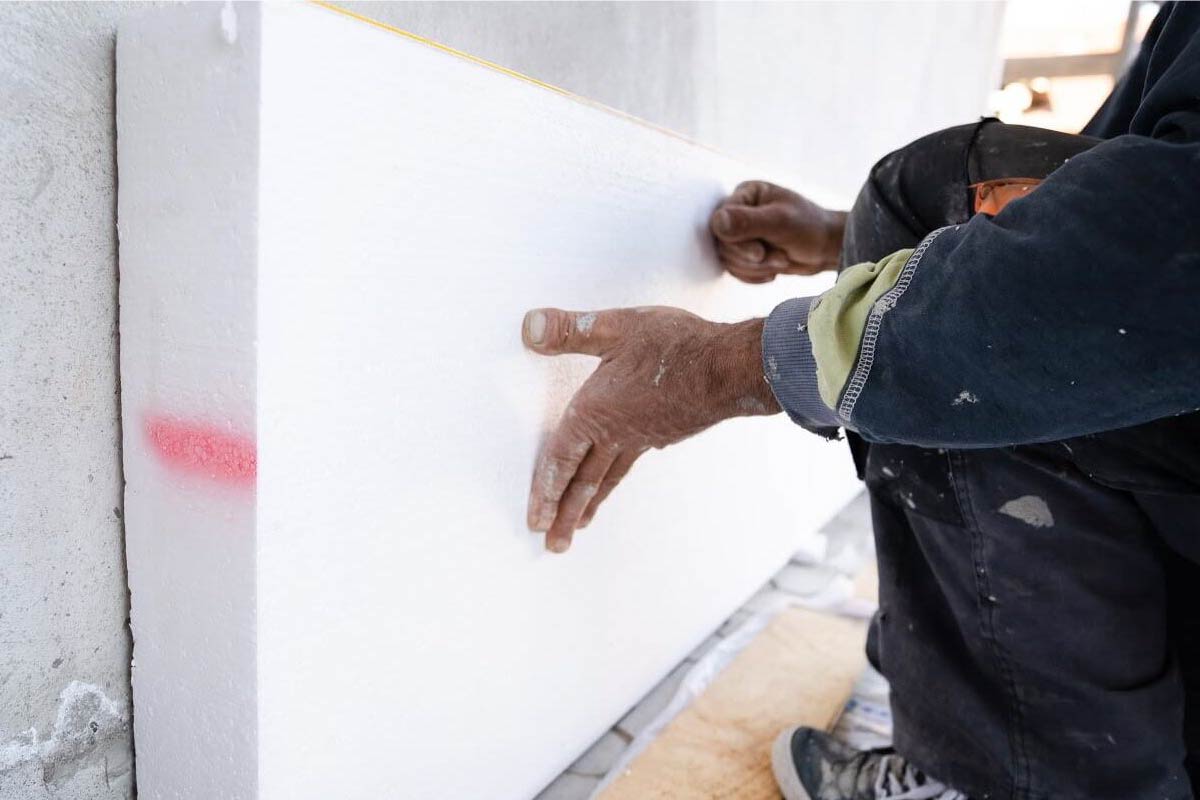Expanded polystyrene, or EPS geofoam, is a cost-efficient insulation material used in the construction industry. It is extremely lightweight, but strong and durable. A versatile building material, it works well for a variety of different applications such as road construction, bridge abutments, slope stabilization, building foundations, retaining walls, stadium and theatre seating, fill for underground utilities and landscaping and insulation for both above- and below-grade applications.
How Is EPS Geofoam Manufactured?
EPS geofoam is manufactured from polystyrene resin beads via a process called polymerization. Pentane, a hydrocarbon solvent, is typically used as the blowing agent during the manufacturing process. First, the resin beads are fed into a vertical tank containing an agitator and a controlled steam input. This stage determines the final density of the material by controlling the length of time the beads remain in the expander and/or the pressure in the expander. By controlling the amounts of heat and pressure applied, EPS geofoam can be created in a variety of densities. In the second phase, the expanded beads, called prepuffs, are dried in the open air for several hours and then, in the third phase, they are transferred to large storage silos. During the storage phase, which may last as little as a few hours to up to three days, the prepuffs are left in the silos until they reach the desired temperature. In the next phase, the prepuffs are poured into molds to obtain the size of material specified. Steam is injected into the molds through tiny slots, to begin the fusion process. During this phase, recycled EPS material is mixed with the prepuffs and is also fused into the material. Finally, the material is released from the mold and stored until dry.
Thermal Properties
R-value is a measure of a material’s resistance to heat transfer. It is dependent upon the thickness and density of the building material. The higher the R-value, the greater the material’s ability to resist conductive heat transfer and the better the material’s performance as an insulating material. EPS insulation has a typical R-value of 3.85 per inch at a mean temperature of 75 degrees Fahrenheit and a typical R-value of 4.17 per inch at a mean temperature of 40 degrees Fahrenheit. According to the U.S. Department of Energy, EPS foam board provides up to two times more thermal resistance than most other insulating materials of the same thickness,
The R-value of EPS geofoam insulation remains constant because the closed-cell structure of EPS geofoam contains only stabilized air. No gases are included. Moreover, a study commissioned by the EPS Molders Association found that the R-value of EPS geofoam does not decrease with age, even under freeze-thaw conditions, whereas other insulation materials can lose R-value over time. EPS is one of the few rigid foam insulations with a stable thermal resistance throughout its life. It also has the highest average R-value per dollar compared to other rigid foam insulation materials.
EPS geofoam is 98% to 99% air by volume. The air pockets that are formed during the manufacturing process make it a great thermal insulator. This means buildings will be cooler during the hot, summer months and warmer during the cold winter months, while reducing the building’s overall energy consumption. Buildings insulated with EPS geofoam insulation are more economical to maintain over the years.
Moisture Absorption Resistance
A permeance or “perm” rating is a standard measure of the water vapor permeability of a material. Unlike the R-value, in which the higher the number, the better, a material with a lower perm rating is better at retarding movement of water vapor. Resistance to moisture absorption is important because water is an excellent conductor of heat.
The perm rating for EPS insulation is 5.0, making it a Class III permeable vapor retarder. But that rating may be misleading. A material’s ability to not only resist moisture but to readily release any moisture it does absorb, referred to as “drying potential,” is also an important factor to consider in an insulation material. The drying potential for thermal insulation is critical to maintaining the structure’s thermal resistance. The perm rating may not be indicative of the long-term results.
For example, in a side-by-side test of EPS and its “cousin,” XPS, or extruded polystyrene, both insulations were used below-grade on a building foundation. After 15 years, both EPS and XPS were removed and tested using the ASTM C1512 test (Standard Test Method for Characterizing the Effect of Exposure to Environmental Cycling on Thermal Performance of Insulation Products). The EPS insulation had a moisture content of 4.8%, compared to an 18.9% moisture content for the XPS insulation. After a drying time of 30 days, the moisture level of the EPS insulation dropped to 0.7% versus 15.7% for the XPS insulation. EPS exhibits a higher R-value over moist-dry cycles, most often seen in below-grade applications, outperforming XPS insulation and providing a long-term R-value to the project.
Other Properties
Compressive strength. High compressive strengths of up to 60 psi make EPS durable and long-lasting and able to stand up to harsh conditions without deterioration. EPS geofoam’s strength is even more amazing considering it is so lightweight. EPS geofoam weighs in at only one to two pounds per cubic foot, depending on size. The compressive resistance of EPS geofoam at 1% deformation ranges from 2.2 psi to 18.6 psi. One pound of EPS geofoam will support 3.5 pounds per square inch while retaining 1% or less deformation.
With a wide range of compressive resistance strengths to choose from, it’s easy to find a solution for most every project. In fact, several different types of EPS geofoam can be specified on a single project to maximize savings.
Ability to inhibit growth of biological air contaminants. Moisture promotes the growth of many organisms such as mold, mildew, fungi and other bacteria. EPS geofoam is water resistant and can inhibit the growth of these organisms.
Durability. Since EPS geofoam is a thermoplastic material, it will not rot or decompose over time. It is also resistant to microorganisms in the soil. And, it isn’t attractive to rats and other vermin as a source of food. It has an incredibly long lifespan – up to 50 years.
Chemical inertness. EPS geofoam is resistant to most acids, bases and aqueous solutions of salts and alkalis. Therefore, it is considered to be a fairly chemically inert material. However, many organic solvents such as acetone, chlorinated solvents and aromatic hydrocarbon solvents can attack the foam and cause it to dissolve.
Size and density. Standard-sized EPS foam insulation is available in multiple sizes up to 36-inches thick and 16-feet long or larger. Because a molding process is used to produce EPS foam, there are more sizes available to select from, compared to XPS foam board which comes in limited sheet sizes. Plus, EPS foam insulation can be fabricated to size or cut into any configuration to fit a specific project’s needs.
EPS geofoam comes in a wide variety of densities, with the most common ones ranging from .75 pounds per cubic foot (PCF) to 3 PCF. Density is a significant driver of cost —the denser the material, the more expensive the cost. Higher densities of EPS geofoam have a greater comprehensive strength than lower densities.
Cost. At about $0.31 per square foot for a one-inch thick panel, EPS geofoam costs less per square foot than any other rigid foam board insulation product. Because of that, it offers more R-value per dollar than other similar products. Getting the maximum performance for the dollar is paramount in the competitive arena of the construction industry. For example, the cost of using a higher strength insulation than the specs call for, say a 100 psi XPS product versus a 40 psi EPS product, can almost double your material costs.
Energy efficiency. The long-term performance advantages of EPS insulation correlate directly to increased energy efficiency and reduced energy costs over the life of the building. And, far more energy is saved over the lifetime of a building insulated with EPS foam board than is used during the manufacturing process for producing the product.
Dimensional stability. EPS foam offers exceptional dimensional stability. The maximum dimensional change of EPS foam should be less than 2%, which makes EPS foam in compliance with ASTM Test Method D2126.
Sustainability. EPS geofoam is 100% recyclable and can be reheated and reformed indefinitely. It can be reused for many different applications or shredded and re-ground and added to the prepuff to be used in the manufacturing process for new EPS geofoam. Up to 10% of recycled EPS geofoam can be used in the manufacturing process. In 2016, more than 118.7 million pounds of EPS geofoam was recycled in the U.S. You’ll find recycled EPS geofoam in everything from insulated cups to outdoor furniture.
And since EPS geofoam is a manufactured product, every time you use it in a project instead of a natural product, you are helping to sustain the environment.
Environmental Impact
EPS geofoam is one of the most environmentally responsible building materials you can specify in your construction project. It uses no harmful greenhouse gases in the manufacturing process — pentane, a hydrocarbon solvent which doesn’t affect the ozone layer — is most often used as the blowing agent. Plus, the product itself doesn’t emit any greenhouse gases. EPS geofoam is free from dyes, formaldehyde, chloroflure carbons (CFCs) and hydrochlorofluorcarbons (HCFCs). EPS geofoam is manufactured using primarily steam, and even the water from the manufacturing process is collected and reused. Since EPS geofoam isn’t biodegradable, it won’t leach into the ground over time, adversely affecting soil and groundwater quality.
EPS geofoam qualifies for Energy Star status, a symbol backed by the U.S. Environmental Protection Agency that signifies the product not only helps businesses/people save money but its energy-efficient properties helps protect the climate. EPS geofoam also has the seal of approval from the American Lung Association. Its Health House Indoor Air Quality guidelines recognize EPS geofoam as a safe material for insulation and structural support in construction projects.







